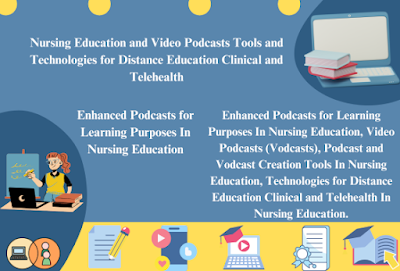The Video Podcasts Tools and Technologies for Distance Education Clinical and Telehealth In Nursing Education. Technologies such as smart wearable sensors for collecting patient data and electronic medication management systems for process optimization can simplify time-consuming tasks.
The Video Podcasts Tools and Technologies for Distance Education Clinical and Telehealth In Nursing Education
These efficiency gains allow nurses to focus on more important tasks and valuable patient time, while reducing the risk of burnout. In her study, Blum (2018) examined the relationship between nursing students’ use of podcasts and the development of critical thinking. Although the results are not statistically significant in this context, the study shows that students enjoy this learning method.
Technology in healthcare can help reduce medication errors, prevent adverse events, and improve patient safety. These include features such as electronic medication administration records (eMARs), barcode scanning for medication verification, and electronic medical records (EHRs) that provide real-time access to critical patient data.
Enhanced Podcasts for Learning in Nursing Education
Enhanced podcasts combine audio with synced images, such as presentation slides, to enrich the learning experience. These podcasts often use the Advanced Audio Coding (AAC) format or Adobe Presenter, which outputs as a PDF or Flash-based file.
Since mobile devices vary in their compatibility with file formats, institutions with mobile device requirements must prioritize formats like AAC or MPEG4 to ensure wide accessibility. Computers and laptops typically have fewer restrictions and can play most file types.
Video Podcasts (Vodcasts) in Nursing Education
Vodcasts add a video component to podcasts, often featuring live-action content of speakers. They are used to increase student engagement and improve the instructor’s social presence. Despite their effectiveness, vodcasts pose challenges regarding device compatibility, as some formats like Adobe Flash are not supported on Apple devices.
Universally compatible formats like MPEG4 (H.264 codec) or HTML5 are recommended. Given the large file sizes of video, it is important to limit the length of vodcasts to under 10 minutes and reduce the playback window size when possible to make files easier to download and distribute.
Tools for Podcast and Vodcast Creation in Nursing Education
Creating simple audio podcasts requires minimal equipment, like a high-quality microphone in a quiet space. Free software like GarageBand (Mac) or Audacity (Mac/PC) can be used for editing audio. Some institutions offer automated podcasting systems that record live lectures, streamlining the process for faculty.
Enhanced podcasts can be created using tools such as GarageBand, Keynote, iMovie (Mac), PowerPoint, and Adobe Presenter. These tools allow faculty to create voice-over narrations synced with presentation slides and output the file in multiple formats, including video (Flash or movie) or a self-contained PDF.
Creating vodcasts requires video capture equipment, from smartphones to professional-grade cameras and microphones. Editing tools like Adobe Premiere, Adobe Presenter, and iMovie help process the video, though more extensive editing may require skilled support staff due to the complexity of these tools.
Technologies for Distance Education, Clinical, and Telehealth in Nursing Education
Technology advancements not only allow students to attend courses remotely but also enable nursing care to be delivered at a distance. Telehealth uses electronic communication tools to share clinical and health-related information, while telenursing involves managing and coordinating nursing care from a distance.
Video conferencing, computers, and remote monitoring equipment can be used by students to perform assessments and interventions from afar, helping them gain clinical experience without being physically present at healthcare facilities. This technology also allows students to practice with tools that are increasingly used in home-based healthcare settings.
Read More:
https://nurseseducator.com/didactic-and-dialectic-teaching-rationale-for-team-based-learning/
https://nurseseducator.com/high-fidelity-simulation-use-in-nursing-education/
First NCLEX Exam Center In Pakistan From Lahore (Mall of Lahore) to the Global Nursing
Categories of Journals: W, X, Y and Z Category Journal In Nursing Education
AI in Healthcare Content Creation: A Double-Edged Sword and Scary
Social Links:
https://www.facebook.com/nurseseducator/
https://www.instagram.com/nurseseducator/
https://www.pinterest.com/NursesEducator/
https://www.linkedin.com/in/nurseseducator/
https://www.researchgate.net/profile/Afza-Lal-Din
https://scholar.google.com/citations?hl=en&user=F0XY9vQAAAAJ
